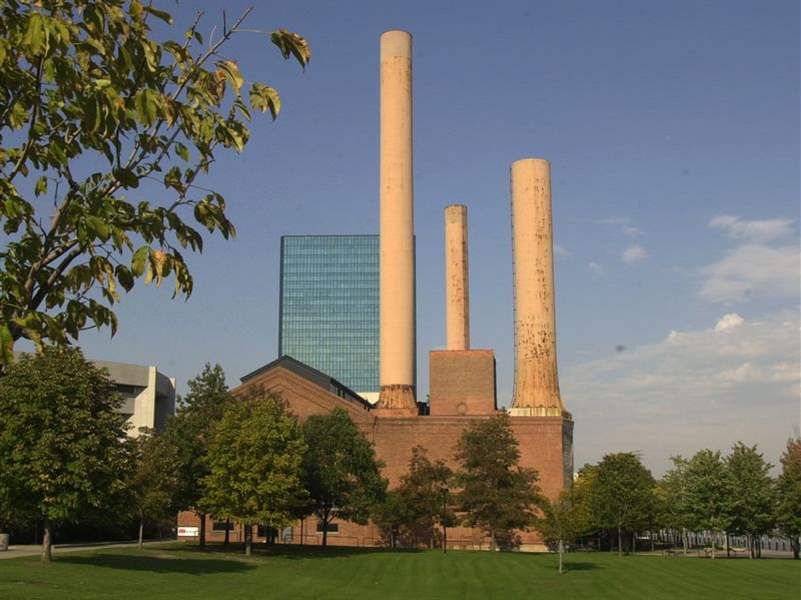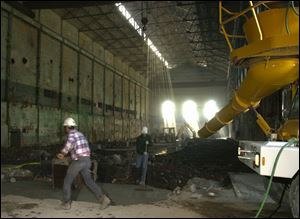
Entertainment complex is beginning to lose steam
11/6/2000
Plans call for renovating the former steam plant into a complex of retail shops, restaurants, and entertainment venues called Water Street Station.
BLADE

Plans call for renovating the former steam plant into a complex of retail shops, restaurants, and entertainment venues called Water Street Station.
The much-ballyhooed Toledo Edison steam plant project will cost between $4.3 million and $8.5 million of mostly public money, and city council is debating whether the proposed development is worth it.
Plans call for renovating the historic steam plant, razing the nearby federal building, and constructing a parking facility on Summit Street at the federal building site to service an entertainment complex at the steam plant.
Costs for the three components are ever changing, as are plans for how the city would pay for the project.
Current estimates are:
The fate of the project rests with city council and some of its members aren't happy.
When Wisconsin developer Randy Alexander sat down with council last week to ask for approval of changes to his contract to accommodate $350,000 of cost overruns, he was met with harsh words, skepticism, and reluctance.
The talk turned to lawsuits and how much the city would be on the hook for if his Water Street Station project falls apart. Council President Peter Ujvagi told the law department to start figuring out what each party's “exposure” would be in the event of litigation.
Deborah Younger, newly appointed assistant chief operating officer and former director of neighborhoods, has shepherded the steam plant project for months.
To her, the question is one of how much council is willing to spend to spur economic development on the west side of the Maumee River.
“Council has to put a value to what they think is worth seeding economic development along the waterfront,” she said.
The city spent $15 million developing the Hillcrest and Commodore Perry apartments, which yielded 200 housing units, she said. Some would argue that it was not prudent to spend that money, she said, adding that council needs to decide what value it places on the steam plant area.
“Our downtown has not reached the density that allows us to let the private sector do it by themselves. We have to spur it [development] so that eventually, we won't have to consider doing it,” she said.
The city assisted in the development of the Docks in East Toledo, which is heralded as the city's greatest development success in recent years, she noted.
But council controls the purse strings. Ms. Younger said, “We believe council now has to act.”
Mr. Ujvagi has expressed concern that the cost of the project has climbed into the millions of dollars, most of which is city money.
Council's first decision will have to be whether to amend the Alexander Co.'s development agreement with the city to allow for completion of the first phase of the steam plant renovation.
The administration is asking for changes to the contract that would give Mr. Alexander three more months to finish his project, would allow him to walk away from the development at the end of phase one, and would require the city to reimburse him $600,000 if he did walk.
Mr. Alexander said the $600,000 - an increase from the $250,000 in his original agreement - would be to reimburse him for the bulk of work he has spent on renovation, including $250,000 he originally agreed to spend, plus more than $400,000 of cost overruns he has encountered on the project.
He said the additional costs occurred when the decision was made to install a steel support system in the building to allow for three more floors to be built in the steam plant. The move increased the plant's 20,000 square feet of space on one floor, to potentially 80,000 square feet on four floors, he said.
In addition to Mr. Alexander's money, the city is spending $500,000 on the renovation and using $800,000 from Toledo Edison to rehabilitate the company's plant, which has been vacant since 1985.
If council does not agree to change the deal, Mr. Alexander has made it clear he will not be able to finish by his Dec. 31 deadline. The city could find him in default and take back the building.
But contracts won't be paid, and “there will be major litigation from a number of players,” he cautioned.
Councilman Louis Escobar said he is not interested in spending any additional money on the project. Councilwoman Betty Shultz questioned what kind of planning Mr. Alexander did to not foresee the need for steel reinforcement in the 19th century structure.
Ms. Younger and others in the administration have been trying to convince council that it is better to extend the contract, so that if Mr. Alexander does walk, he will leave the city with a building that is ready to market for tenants.

Workers smooth out the concrete they have poured inside the former Toledo Edison steam plant.
“We believe it's not in the best interest of the city to stop in the middle of the project. ... We have to do something to complement and tie in with the stadium and activity on the west bank of the Maumee,” she said.
Councilman Pete Gerken said he does not think Mr. Alexander will stick with the project if given the option of leaving.
Mr. Gerken said he is concerned that lawsuits have taken their toll on the Alexander Co., and that Mr. Alexander is looking to cut his losses.
In 1997, the Kimberly-Clark Co. sued the Alexander Co. over the LaSalle and several of the company's renovation projects, which the paper company financed. Alexander Co. counter-sued Kimberly-Clark, and both suits are still pending, Mr. Alexander said.
He said Mr. Gerken is mistaken if he believes the company's capacity is an issue.
Ms. Younger believes Mr. Alexander's track record as developer of Toledo's LaSalle and Hillcrest apartments shows he is committed to the city. Financially, it's in his best interest to stay, because he will make his money when he markets the building for tenants, she added.
Mr. Alexander said he has shown good faith by staying for eight months, even though the city can't guarantee him parking.
The parking debate began because Mr. Alexander believed he was free to put parking on the waterfront side of the steam plant, but that plan was rejected by Mayor Carty Finkbeiner.
Whether he would stay after phase one would depend on several factors, including parking. Without parking, finding tenants will be difficult, he maintains. However, he suggested the project could be changed from retail to residential, and then parking would not be an issue.
One of the biggest unknown factors continues to be how much a parking structure will cost.
Plans have wavered from a standard surface lot, to a parking deck with a landscaped plaza on top to camouflage parking so close to the riverfront and allow for an unobstructed view of the Maumee.
Cost estimates, which began at $450,000, have increased to somewhere between $1.2 million and $5.3 million, and Ms. Younger admits, the cost will likely be closer to the $5.3 million figure.
Most plans involve paying for the work with city capital improvement money and the sale of bonds, which would be paid off with parking fees from the lot.
The Downtown Toledo Parking Authority told council and the administration it opposes putting parking at the federal building site, which the agency views as prime, waterfront property.
The authority, however, told the city if it was going to put parking there anyway, the agency would participate in the project to make sure it was done right, Clayton Johnston, president of the parking authority, said.
He said the cost of a parking facility is so unclear because no design has been done on which the city could begin to calculate construction costs.
Mr. Johnston cautioned that he does not think the city should build anything until leases are signed for at least half of the steam plant's first floor space. Spending millions to build parking based on letters of intent would not be prudent, he said.
Mr. Johnston said he does not buy Mr. Alexander's argument that he can't find tenants without a guarantee of parking.
But before council can decide whether it will build parking, it first needs to approve the money to tear down the federal building.
Council rejected the administration's first plan for federal building demolition, accusing the mayor's staff of robbing council projects to find the money for the razing.
The administration is proposing a plan that uses $500,000 of federal money secured by U.S. Rep. Marcy Kaptur (D., Toledo), plus $620,000 from the city's 1999 and 2000 capital improvement budgets to pay for the demolition.
Juanita Green, director of economic development, and John Sherburne, acting commission of economic development, told council $420,000 of the city's contribution would come from money set aside in the 2000 budget for downtown development.
Another $200,000 would be taken from money in the 1999 budget that was earmarked for an industrial park at a former brownfield site at Miami Street and Oakdale Avenue.
Councilman Robert McCloskey balked at the idea of taking money away from a project in his East Toledo district that he wanted to see go forward.
“We can't, at this time, move that money to some other project. That project would have moved two years ago if the development office was stable,” he said.
When the administration proposed the idea last week, council ordered it sent back to the administration so the money would come from the “right funds” and council's “priorities are respected,” Mr. Ujvagi said.